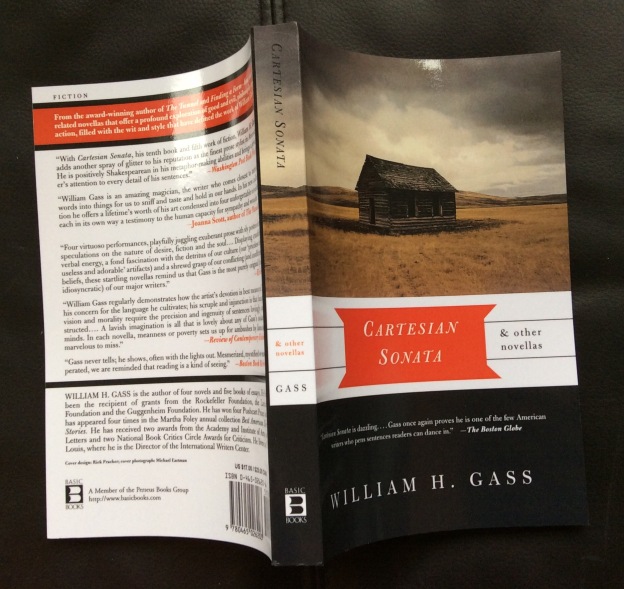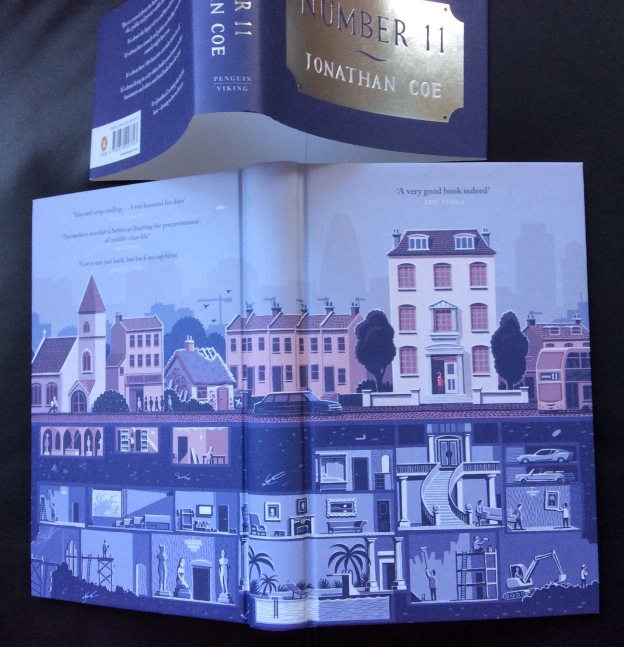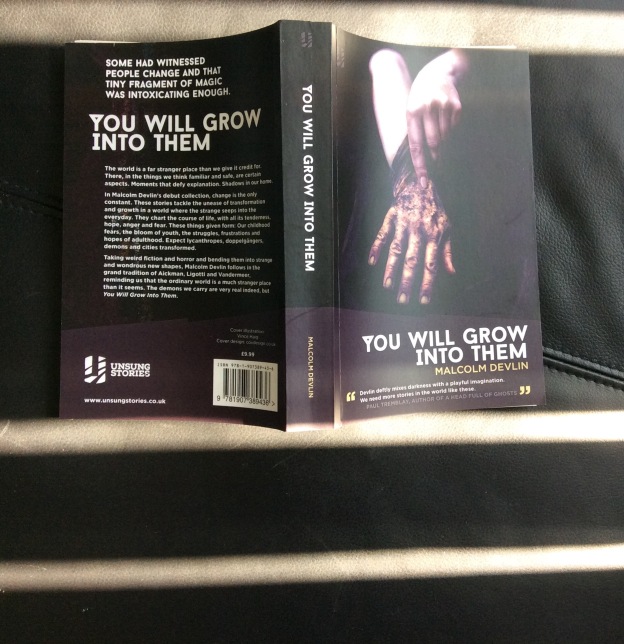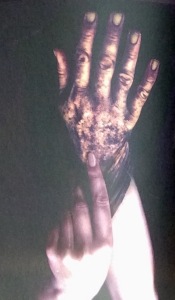CARTESIAN SONATA & other novellas – William H. Gass

BASIC BOOKS 1998
My review of OMENSETTER’S LUCK: https://dflewisreviews.wordpress.com/2017/01/01/omensetters-luck-william-h-gass/
My review of THE TUNNEL: https://dflewisreviews.wordpress.com/2017/01/06/the-tunnel-william-h-gass/
When I real-time review the first three novellas in CARTESIAN SONATA, my comments will appear in the thought stream below ….







THE CARTESIAN SONATA
The Writing on the Wall“Shall we play a few more games? Tromp about in the rosin box, it’s slippery on the wire. […] Adam — wheedle by wheedle — in the same way, got existence.”
Ella Bend Hess is introduced, amid writerly wrestling with words, including the words in the Biblical book of Daniel. And other characters that are digressive. And shoes and slippers, and the salesman purveying such objects. Earlier today, I read a story elsewhere about shoes stalking and haunting the protagonist.
“Bless me. The careful reader. I had forgotten him. […] …I don’t wear a thing when I write but work naked and compose by staring at my cock and balls.”
Pages 25 – 35
“The world rolled through her like a sea, the skin no seawall to it, and no one afloat in that tide could have guessed by a sky change or by any other that they had been swept beyond her body wall and bobbed now in the basin of her brain.”
We now continue Ella’s backstory, her insurance husband, her clairvoyancy, a typical Gass-filled texture that out-Joyces Joyce, in a good way, second to none for deep transformational structures of bodily fluids and bodyprint, words as sinew and more.
It also inadvertently and generally chimes with Melanie Tem’s versions of different types of Ella that I am concurrently reading here. Shoes, missing toes, and all
“Ella Bend could be called clairvoyant simply because she possessed an abnormal number of sensitive receivers. She was almost totally attention and antennae.”
I happen, by chance to be concurrently real-time reviewing the selected poems of Fiona Pitt-Kethley (here), and I sense a similar soul behind the prose-poetic words of Gass with the poems (some of them prose-by-hindsight-enjambment) of Pitt-Kethley, whether that linked soul be by dint of authorial soul or the soul of the woman being depicted. I often feel a serendipity reaching between works, allowing readers or writer of one to be led to the other, by a synchronous or preternatural power, and vice versa, by cross-references in a hyperlinked labyrinth such as the one this site has become over the years.
Here there is an unforgettable long passage about words in a dictionary, and the alphabetical order by actual texture, shape and spelling of the word, being significant…
“And what lies so snugly between ‘truism’ and ‘truly’? ‘Trull’! That’s right — truth is a strumpet.”
“Mud, mold, matter — what one called it didn’t count — but it had neither courage, nor loyalty, nor conscience.”
The language is matter, the reader is the mind. The language here is actually chips off old blocks, with body parts, and body effluence, and sex. You will never meet language quite like this anywhere else, putting live flesh into words and leaving it to rot or fecundate itself. It is Ella’s husband as matter, and I sense he has already been dead, now brought back to life, to light, to MIND, in a Cartesian sense, with this atonal sonata of solid music in the form of words. Brought to re-existence and narrative point of view by the fiction-erected incarnation of Ella’s clairvoyance as a creative force rather than just a scrying one, and by referral his mind is ignited again and wakes to Ella as a view he has of his once-upon-a-time wife who is dying or now dead instead of him, while all the time she is inadvertently re-creating HIM, or bringing him back into the world as a thinking confusion like a lunatic in the same way as René Descartes had a thing about dreams being what a lunatic thinks in life, [trumping out the Trump for this world, even though such a character has, all this time, lain in abeyance all these years in this text without being thus correctly identified as Trump? We just need to find the woman who is inadvertently ‘holding’ him alive, by dint of her special form of clairvoyance created in this living text, holding him in her mind like real matter. We simply need to tell her to stop doing it (e.g. I wish you wouldn’t) within this leasehold fiction. Or destroy all copies of this book, but we would still have a problem if its freehold author is still alive and will not stop holding it in HIS head?]
(My wild extrapolations within square brackets.)
BED AND BREAKFAST
1“…and here was ‘Ann Lee’s & Other Stories’. What the hell? That was no proper title. Ann Lee’s what? Elizabeth Bow-… the spine was smeared, the black had run. Bowen. Bet it wasn’t Ann Lee’s quim.”
This is a fascinating and pungent portrait of a low-key travelling businessman checking into a motel room, finding a ‘secretary’ full of old books, that we explore with him, their titles, bookshapes, contents, pencilled marginalia (like mine?), and mixed in with these book explorations are carnal thoughts of his wife Eleanor and his Girl Friday Miz Biz, and more. Why has literature not marked this striking chapter as one of its landmarks?
Perhaps this book’s an example of those ‘abandoned’ ones in the motel room, now rediscovered?
“As his eye sniffed idly about, released like a dog from his thoughts, every surface which shaped the room and sheltered him seemed to be drawing aside like drapes, but their shiftiness made nothing more spacious for him.”
Riff is the name of this travelling accountant, one with theories about deliberate insurance losses, here finding suitable b&bs via the b&b booklet, this one, or is it a customer, too, full of objectilia, and if the bathroom is like this –
… you can imagine what sort of bric-à-brac the rest of the place contains. Clutter and chintz as sort of spiritual angst? And not sure he's seen the back garden yet?
A cluttered intellect, too. Easily waylaid.
“…more objects he hadn’t noticed when he’d first come in began to solicit his attention.”
In his Walter persona, Riff is almost absorbed in the lists he creates, and I now see my photo above may not be an exaggeration. This is amazing stuff that I recommend to all readers or students of literature. A book that might only otherwise have previously been found in an unlikely array of objects you have not yet really looked at?
5 – 6
“At last, Walter slid naked between the cool sheets, as careful as if he were a layer himself, and felt their cool calming touch, the touch of an other who wanted nothing from him but would grow warm when he relaxed and went to sleep in his skin.”
The whole Aesthetic of this Walter Riff’s bed and breakfast stay, Bettie saying Grace at breakfast itself, as if thanking God not for the forthcoming breakfast but for what happened during the night?
The objects, some precise and meticulous, cluttered as well as ordered, plush and ordinary, stacked and coagulated, while separated, too, are like Trump’s mind today, and each itemised separate Patna rice tweets…
“The world was flooded with ruck. And these things had made their way here, sometimes, like the corded candles, even two by two, to Bettie’s Bed and Breakfast, where they might be borne away in safety, surrounded by peace and solicitude.”
Gass works. The books again as part of the mass objectilia of emotional objectification, wherein a book of Frost poems, and a tussling with the words ‘befit’ and ‘bereft’, a model schoolhouse with strangely pinging bell, and memorising the date of every penny as part of an accounting process. Does Riff stay in this B&B with his monetary machinations and lending a hand in kind as part of that process? This is literature made out of things, collections of words, as well as the objects the words represent. No real comparison to Gassworks. Experience something unique.
EMMA ENTERS A SENTENCE OF ELIZABETH BISHOP’S
Pages 144 – 153That must be among the most striking openings to any literary work.
From outset, it seems, so far, to turn into a staggering theme and variations on the novella’s title where words become prehensile shapes or feathered creatures, hard-nosed as well as poetic, and sinuously flowing, being compared to the ‘cloud’ that it mentions, too, prophesying the new version of ‘cloud’ today wherein words float like the hopefully eternal ghosts of birds?
.
The slow fall of ash far from the flame, a residue of rain on morning grass, snow still in air, wounds we have had, dust on the sill there, dew, snowflake, scab: light, linger, leave, like a swatted fly, trace to be grieved, dot where it died.
That is the sentence of Bishop’s Emma enters. Here a gestalt of Gass driven words you cannot possibly imagine being possible until you read them here, strung together with pain and murder. From flat, unpenised babychild, in desiccated interface with her father… and mother. And the words as concupiscence made semantic, beneath the desiccation. Matchless material that cannot be demonstrated here, not done justice to, simply let it flow over you. The Poetics of Pain. Edith Sitwell, too.
Punishments to fit the crimes…global as well as individual.
I think all that needs to be said about this final novella, Gass-piped with scatology of revenge and resentments and sensitivities akin to Trump’s, is said here:
https://books.google.co.uk/books?id=yEbQDEngXTsC&pg=PA153&lpg=PA153&dq=%22master+of+secret+revenges%22+gass&source=bl&ots=o9CQq2grzX&sig=2zGHLD5BjTGNl3GVd3xxv2XBpc0&hl=en&sa=X&ved=0ahUKEwiT8brDvMnTAhUlLMAKHXRWBmcQ6AEIHjAB#v=onepage&q=%22master%20of%20secret%20revenges%22%20gass&f=false
Should hopefully put Trump in an underground cage, too.